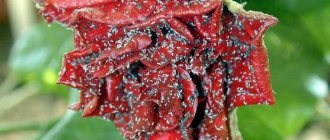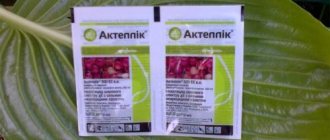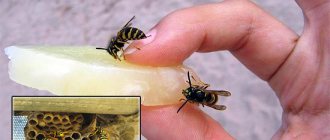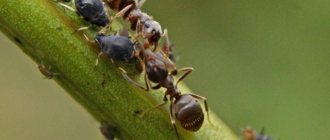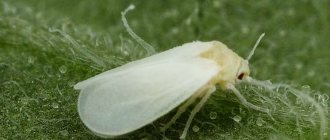The strawberry or strawberry nematode is a microscopic worm that causes enormous damage to plants. Affected plants stop growing actively and wither. In advanced cases, it leads to crop loss. It is difficult to completely get rid of this problem. The best way to combat nematodes can be timely prevention.
Dear readers! For you, we have created communities on social networks in which useful articles and interesting ideas are published several times a day! Subscribe and receive useful content in a convenient format!
Description
The nematode is a very voracious and tenacious pest. Even eggs can remain in the ground for up to 10 years , after which they hatch. It is not easy to detect; the size of this roundworm is from 1 millimeter to 2 centimeters.
What is a nematode - biological description
A nematode or Nematodes is a roundworm belonging to the phylum Protostomes.
The body color is white, sometimes yellowish. Males and females are easily distinguished by body shape. Females are rounder because they carry the eggs within themselves.
The nematode's mouthparts resemble small forceps. With the help of this organ, it is tightly attached to the stem or roots of garden strawberries. After which it actively feeds on the sap of the plant.
Reference! Eggs and adult nematode worms hide in the soil. This is an additional circumstance that makes them difficult to detect and remove.
Types of nematodes
It parasitizes not only strawberries, but also other plants. It could be:
- Golden potato. It affects exclusively plants of the Solanaceae family. The greatest danger is for potatoes. The leaves of the affected plant turn yellow and wither, flowers and tubers do not form;
- Root gall. It parasitizes exclusively on the roots of various vegetables. Each plant species is affected by its own subspecies of nematode. As a result, plants rapidly lose moisture. As a result, their development slows down and productivity decreases;
- Stem. It is most dangerous for plants such as garlic, onions, potatoes and some garden flowers;
- Leafy. These are colorless worms only 0.5 - 1 millimeter long. Lives in the leaves of many plants. Most often found on chrysanthemums, strawberries and tomatoes.
Strawberries or garden strawberries are affected by leaf and stem forms.
Attention! The most common parasite on garden strawberries is the stem nematode.
Folk remedies
If a nematode is detected on strawberry bushes, action must be taken immediately. Affected plants should be burned to prevent further spread of the worms. To protect the remaining plants from worms, use hot water treatment or herbal infusions.
Hot water treatment
The method is effective for combating strawberry nematodes at the initial stage of infection of the root system. The seedling must be dug up and the soil washed off with running water. Next, the root is placed in hot water at a temperature of 40-50ºC for 15 minutes. Temperatures above this will lead to the death of the bush. After treatment, the plant is planted in a new place; before replanting, the soil is first dug up.
Herbal infusions
To eliminate nematodes, water or spray with natural decoctions and tinctures. The juices of these plants are toxic to nematodes. Boiling water is used to prepare solutions.
| Plant name | Quantity of raw materials | Water volume, l | Duration of infusion, hours. |
| Marigolds (flowers) | 1 kg | 10 | 48 |
| Calendula (inflorescences) | 5 tbsp. l. | 5 | 24 |
| Nasturtium | 300 g | 5 | 48 |
| Nettle | 1 kg | 10 | 72 |
| Hogweed | 0.5 kg | 5 | 24 |
Folk remedies can be used in any period of strawberry growth. Natural decoctions do not affect the taste of the fruit.
Onion broth
To prepare the solution, you need dried onion (30 g of raw material per 5 liters of water).
Nematode on strawberry
On strawberries it can radically reduce the yield of the plant. The best time for its development is in May - early June. It is at this time that flowering and fruit formation occur, which greatly weakens the plants. The berries become small and ugly and lose their attractive taste.
Peculiarities! Good prevention of nematode damage is varieties that are resistant to the effects of this pest.
What does the affected plant look like?
The nematode is extremely difficult to see with the naked eye. Its presence can be determined by indirect signs:
Swelling on the stem or leaf veins;- Shortening and curvature of petioles;
- Wrinkling and subsequent death of leaves;
- Deformation and reduction of the ovary;
- Specific swellings or galls form on the upper side of the leaves.
The growth of bushes slows down sharply, the plants seem to be “pressed” to the ground. Spreads through infected plants.
Reference! Infected seedlings can be identified upon inspection. In the earthen coma you can see white dots reminiscent of semolina. This is what female nematodes look like, filled with eggs.
What harm can it cause?
Different types of nematodes live in the soil. But they are dangerous only in high concentrations around the plant.
Attaching to the stem and leaves, the worms suck out the juice from them. At the same time, they inject a special chemical into the plant.
It makes the stem or leaves more suitable for the pest.
Another serious danger is the infection of damaged plants with infections.
The nematode becomes a serious threat at concentrations of more than 1,000 worms per square meter. This is possible due to the enormous fertility of females. At one time, they are capable of laying up to 2-000 eggs at a time.
Attention! The nematode additionally serves as a carrier of viral and fungal diseases.
When does a nematode attack strawberries?
The nematode needs warm weather +24℃…+30℃ to survive. In warm regions, this period begins already at the beginning of spring, in cold regions closer to summer. But the peak development of the worm occurs in May - early June. At this time, the bushes bloom and fruits form; the worm has all the prerequisites for active reproduction. In unkempt areas overgrown with weeds and poor drainage, the nematode spreads quickly. The worms do not move on to another until they finish eating one bush. The soil acidity favorable for the reproduction of nematodes is 5.5 -5.8 pH. Initially, this worm is brought into the garden with new seedlings. It can also spread throughout the area using gardening tools.
How to fight the disease
Once a nematode appears, it will be quite difficult to get rid of it. The removal process from the site may take longer than 3 months. The following methods can be used for this:
- Agronomic (these include deep digging of the earth, soil optimization and changing the planting site);
- Mechanical (treatment of the root system of plants with hot water);
- Chemical (nematicide treatment);
- Biological (planting plants next to the bed, the proximity of which is not tolerated by nematodes).
More information about the fight against nematodes can be found in the video below:
Severely affected bushes should be destroyed immediately. This will prevent infection of healthy plants. The best effect is achieved by a combination of these measures.
Reference! It is impossible to completely get rid of nematodes from an area. But you can reduce its amount to an acceptable amount.
Method of treatment with folk remedies
Proven folk remedies include hot water treatment. The method is effective at the initial stage of root infection. Thus, it is possible to “cure” seedlings if female nematodes are found in the root coma of the soil. For this:
- Dig up a mature bush. If we are talking about seedlings, they are carefully removed from the pots;
- Thoroughly wash off the soil and nematodes from the roots. This water should not be used for watering other plants or for composting;
- The roots of the plant are immersed in a container of water. A water temperature of 45 - 50 C will ensure the death of not only adult worms, but also eggs. Do not use hotter water so as not to damage the bush. Keep for 5 to 20 minutes.
After this, the bush is carefully transplanted to a new place and watered abundantly. Spraying with decoctions of plants that are poisonous to nematodes also has a good effect. It can be:
- Marigolds (1 kilogram of inflorescences per 10 liters of water, spray the bushes with a filtered solution;
- Calendula (1 spoon of flowers per 1 liter of water);
- Large nasturtium (300 grams of plants per 1 liter of water);
- Onion (30 grams of dry plant per 5 liters of water).
Unlike chemical nematodocytes, spraying with plant products can be done during flowering and ovary formation.
How to treat with chemicals
The most popular nematicides include:
Mercaptophos;- Ruskamin;
- Lindan;
- Heterophos;
- Phosphamtide.
The solution is prepared and used according to the instructions included with the drug. Treatment is usually carried out before flowering begins.
It is recommended to carry out excavation work after treatment only after 45 days.
Carefully! Nematicides are highly toxic. Work must be carried out using personal protective equipment. These include a respirator, gloves and thick clothing.
Strawberry varieties resistant to nematodes
If the site already has such a problem, it is worth paying special attention to prevention.
One of the most effective measures is the use of pest-resistant varieties. The most popular of them:
- Festival;
- Saxon;
- Granddaughter;
- Pearl mussel;
- Rocket.
At the same time, they have strong immunity to viral and fungal infections.
Peculiarities! The use of resistant varieties is the prevention of the most dangerous fungal diseases of garden strawberries.
Preventive actions
- Before planting strawberries, dig the bed deeply and treat the soil with steam or hot water.
- Also, before planting, enrich the soil with compost, as it contains predatory fungi that kill parasitic worms.
- Plant phytoncidal plants around the perimeter of the bed to repel parasites.
- Do not plant nightshades and legumes nearby - they attract nematodes.
- Throughout the growing season, treat the bushes with a growth stimulator once every 3 weeks to strengthen the immune system.
- Regularly apply potassium fertilizers to the soil.
- Change the landing site every five years.
- Inspect the bushes as often as possible for the presence of parasites, insect pests and infectious diseases.
- In the fall, remove all plant debris from the site, in which the parasitic worm can overwinter and become active in the spring.
It is better to carry out basic control measures in the spring, even before planting. In addition, strawberry varieties that are resistant to nematodes should be selected. These include:
- winter-hardy Rocket;
- early maturing Granddaughter;
- large-fruited pearl mussel;
- high-yielding Saxony;
- unpretentious Festival;
- resistant to gray rot and Elsant spot.
Prevention measures
Measures to prevent nematode infection include:
- High-quality planting material. Most often, infection occurs through infected seedlings. It is worth purchasing it in nurseries or trusted stores;
- Pre-planting treatment of plant roots with drugs such as Paradrion or Fosdrin;
- Adding compost to the soil. The fungi contained in it destroy nematodes;
- Regular transfer to another place. It needs to be done every 4 – 5 years.
Planting plants with an active scent next to the strawberry beds helps.:
Marigolds (example in the photo on the right);- Nasturtium;
- Medicinal calendula;
- Rudbeckia pilosa; Coreopsis Drumond;
- Gaypardia is beautiful.
They can be planted around the perimeter of strawberry beds, providing reliable protection.
Signs of strawberry nematode infection
Diagnosis in this case is complicated by the fact that the worm is very small in size, and therefore it is practically impossible to detect it at an early stage. In most cases, the appearance of a nematode on strawberries is indicated by the appearance of the bush and, as can be seen in the following photo, such signs resemble a nutritional deficiency:
- the growth and development of plants is suspended;
- Although the ovaries and fruits are formed, their shape is disrupted;
- the leaves become smaller and curl up, and on their upper side you can find swellings - galls;
- When the petioles are thick, they are shortened.
By sticking to the body of the plant, the small nematode damages the tissue, and these areas become ideal soil for the development of fungal diseases and infections, and therefore treatment of strawberries must begin immediately - at the first symptoms of infection.
On a note! Nematodes are always present in the soil, and it is impossible to completely get rid of them. However, when their numbers are small, parasites are not capable of causing significant harm. Large accumulations of nematodes in one place pose a danger. By the way, this is precisely what explains the defeat of single strawberry bushes on the site. So-called bald spots are created in plantings. At the same time, complete destruction is extremely rare; such a situation is only possible if there are thousands of nematodes on every square meter!
Optimal conditions for successful development of the parasite
The nematode appears on strawberries under certain conditions, when the air temperature rises to +24...30°C and the soil acidity ranges from 5.5 to 5.8 pH. And the reason for the occurrence of the parasite in high concentrations is the use of infected seedlings.
Nematode eggs can remain viable for several years and become active when favorable conditions occur.
Mistakes when fighting strawberry nematode
To reduce the risk of nematodes, it is important not to repeat common mistakes:
- Use of insecticides. They are effective against insects, but are completely useless against nematodes;
- Throwing affected plants into compost. Nematode eggs have excellent vitality for up to 10 years.
It is dangerous to ignore lightly infected bushes. At this stage, the affected plants can be cured in time. Even 1–2 bad-looking bushes should alert you.
The nematode or roundworm is one of the most dangerous pests of garden strawberries. These microscopic worms infect the leaves, berries, roots and stems of the plant. Getting rid of the problem is difficult, since eggs and adults are quite tenacious. Spreads through contaminated planting material or soil.
Chemical control methods
To combat the pest, nematicide drugs, organophosphorus compounds, contact poisons mercaptophos, ruskamin, and lindane are used. It is recommended to carry out the work before the formation of ovaries; during the period of fruit formation, the use of chemicals is prohibited. Examples of preparations for strawberries against nematodes:
| Name | Efficiency, features, how to process |
| Heterophos | To prepare a solution, add 15 g of a chemical to 10 liters of water. It is allowed to spray and soak the root system of the bush before planting it in the ground. The active component is highly toxic; personal protective equipment must be used during operation. |
| Phosfamide (0.05%) | The active ingredient is slow-acting, treatment is carried out after 5 days. |
| Copper sulfate | Irrigation is carried out in early spring, on the eve of the growing season. |
| Skor, Fundazol | The plant is sprayed after harvesting, as well as to disinfect the holes before planting strawberries. |
When diluting the drug, you should follow the dosage instructions and the permissible time period for treatment.
To destroy the strawberry nematode, you can use medications intended for the treatment of helminths in humans: Decaris, Piperazine. To prepare the solution, you need 1 tablet of medicine per 10 liters of water. It is impossible to completely eliminate the pest in this way; the toxic composition affects only adult individuals.
General description of strawberry nematode
The nematode belongs to the class of roundworms. The worm chooses not only strawberries and wild strawberries as a host, but also other plants (potatoes, onions, garlic, raspberries and some ornamental crops).
The disease caused by infection with nematodes is called nematodosis. Strawberries are affected by stem and leaf nematodes. The pest lives in the upper layers of the soil.
Abundance of nematodes on strawberry roots
Using a mouthpart similar to forceps, the parasite securely attaches itself to the berries and leaves of the plant, sucking nutrients from it.
During nutrition, an enzyme is introduced into plant tissues that disrupts metabolic processes. As a result, the leaves and berries change shape, which becomes the most convenient for the worm to live in.
Males and females mate in the leaf axils and buds of plants. The main feature of the worms is that females accumulate embryos within themselves, transforming into cysts. For embryo development, a humid environment with a temperature of 18-24°C is required. When heated to 40°C, eggs, larvae and adults die.
Each year, each female parasite produces up to 2 thousand new worms. The nematode overwinters in the above-ground parts of plants, safely enduring the most severe frosts.
What does a nematode look like?
Strawberry nematodes (Aphelenchoides fragariae) are tiny worms with a cylindrical body that tapers to a point.
The worm's body color varies from white to yellow. The length of females does not exceed 0.65-1 mm, and the thickness is 0.015 mm. Males are smaller in size.
Due to its tiny size, it is impossible to see the parasite with the naked eye.
Nematode eggs are oblong, placed in a narrow long capsule. Larvae differ from adult individuals not only in their smaller size, but also in their imperfect digestive and reproductive systems.
How to recognize an infection
Of course, the photo of the strawberry nematode is only on an enlarged scale.
Infection of berry plantings can be recognized by the following signs:
- plant growth slows down and then stops altogether;
- the leaves of the plant turn yellow at the initial stage of infection, and turn red as the disease progresses;
- thickening of the veins of the leaves occurs, becoming yellow;
- spots appear on the leaves and stems of the plant, the color of which varies from pale green to dark brown;
- the central part of the bush gradually dies off, which indicates a deficiency of nutrients;
- rosettes of garden strawberries are deformed and the mustaches are shortened;
- peduncles become small, the number of flowers decreases sharply.
Treatment of strawberries from nematodes: sequence of actions
Treatment of strawberry diseases caused by nematodes is carried out according to the following scheme:
- In the spring we conduct an audit of plantings, inspecting the bushes every week. During the same period, we add fertilizers containing potassium and organic matter. Wood ash shows good results in this case.
- During the entire growing season, we use effective microorganisms and treat the plantings several times with growth stimulants (Epin), the action of which is aimed at strengthening the plant’s immunity.
- We dig up all infected bushes and treat them with hot water.
- After picking the berries, we use chemicals.
- In the fall, we add phosphorus-potassium fertilizers to the soil.
What is a nematode?
Nematodes are miniature roundworms that parasitize the stems and root systems of plants.
Many people confuse this parasite. In the photo is Kivsyak, we were also mistaken. Thanks to the guys from the comments, THANK YOU SO MUCH!
Sucking out life-giving juices, they cause irreparable damage to tissues, filling the plant with their harmful secretions. They prefer to be located on the upper young buds and leaf axils.
Appearance
- Male nematodes look like a thin thread 2 cm long and yellowish in color.
- Females are much shorter and skinnier because they carry hundreds of microscopic eggs. They are incredibly fertile, producing offspring up to eight times during one season.
Features of the parasite
The nematode is highly resistant to various unfavorable factors, and sometimes it can be quite difficult to cope with it.
Fighting nematodes is extremely difficult, but possible.
It should be remembered that this parasite is constantly present in the soil, but in small quantities it does not pose a particular threat. It is much worse when nematodes accumulate in one place. As practice shows, most often single bushes on a site are affected when gaps accidentally form in the plantings . Damage to absolutely all strawberry bushes on the site is a rare occurrence.
Types of nematodes
Nematode worms belong to three genera: leaf (Aphelenchoides), stem (Ditylenchus) and root gall (Meloidogyne marioni).
1. Leaf nematodes are thread-like roundworms up to 1 mm long. They move very quickly and parasitize the leaves of plants. Most often, leaf nematodes attack chrysanthemum, garden strawberries (strawberries), nephrolepis, etc. Along the way, they spread viral diseases. Leaves affected by the nematode are covered with dry spots of dead tissue, located in a random order. The leaf wrinkles, turns brown, dries out and dies
Deprived of an important element, the plant dies. Nematodes overwinter in fallen leaves, and use soil as an intermediate “stop.”
2. Stem nematodes look like thread-like roundworms up to 1 mm long and infect the stems, leaves, buds and flowers of plants. They penetrate through the roots and especially often affect plants such as onions, garlic, parsley, parsnips, tomatoes, cucumbers and radishes. The stem nematode actively secretes toxins, leading to blockage of the plant’s blood vessels and thickening of its tissues. Damaged plants should be burned immediately.
3. Root (root-knot) nematodes are roundworms up to 2 mm long that damage the root system of plants. Galls or thickenings form on the roots at the affected sites. The swellings cover the entire underground part of the plant, making the above-ground part look as if it is lacking nutrients and moisture. The plant looks depressed, stops growing, the leaves curl and dry out. The disease is usually discovered only after the plant is dug up and dead roots that have become whitish and thread-like are identified. It is almost impossible to save damaged plantings. Most often, root nematodes affect cacti, chrysanthemums, dracaena, asparagus, ficus, begonia, lily, cyclamen, fatsia, etc.
Chemicals against nematodes
Since it is often quite difficult to fight nematodes on strawberries, many gardeners turn to chemicals for help to achieve quick positive results. The most popular are:
- “Heterophos” - the working solution is prepared from 15 g of the substance dissolved in a bucket of water. Plantings are processed at +20°C. Seedlings can be soaked in the same liquid. Excavation work is carried out only a month and a half after using this product.
Important! The drug "Heterofos" is highly toxic, and therefore it is allowed to work with it only in protective equipment: gloves, thick clothing and a respirator!
- “Phosphamtide” - a 0.02% solution of the drug is used for treatment, carried out every 3-5 days.
- "Mercaptophos" - used similarly to "Phosphamtide";
- "Lindane" or "Ruskamin" - used similarly to "Phosphamtide" and "Mercaptophos".
Signs of a bush being damaged by a nematode
There are a number of symptoms of “disease” that may indicate that a bush is infected:
- Stunted growth of affected plants;
- Specific deformation of the leaves: they take on the appearance of corrugated paper with lines of “broken” veins, the appearance of a pronounced shine of the leaves;
- An increase in the thickness of the cuttings, their curling, a change in color to red shades;
- Changes in the shape and size of berries.
Evidence of infection of the crop with a nematode is the detection of white formations on the elements of the root system, similar in shape to poppy seeds. These are worm eggs that tightly fit the roots of the plant.
For a more accurate diagnosis of roundworm damage, you should contact an experienced gardener or conduct a water test yourself: place the infected roots in water for several hours.
A positive result is the appearance of barely noticeable yellowish “threads” on the surface of the liquid.
Beginning gardeners should remember that nematodes on strawberries are also a frequently described phenomenon in gardening. Signs of damage correspond to the symptoms of the disease for strawberry bushes.
Measures to combat nematodes and methods of prevention
One of the simple ways to prevent the spread of nematodes on a site is crop rotation. Nematodes are pests of a specific plant and cannot feed on anything other than the host plant. Therefore, it is necessary to draw up a crop rotation scheme so that after infection with a nematode, the crops affected by them are not grown in the affected area for several years.
During this period of time, the nematode larvae should gradually die. The difficulty in controlling nematodes in this way is that they have the ability to remain viable for quite a long period of time.
For planting, use only healthy plants and cuttings.
Spray indoor plants no later than five to six hours; the leaves after spraying should dry out overnight.
If the air temperature in the room is very low, keep the plants dry.
Some types of nematodes die when the soil dries out. They can be destroyed by spreading the soil in thin layers and letting it dry thoroughly.
To avoid nematode damage to indoor plants, do not use untreated garden soil for indoor plants. Before use, the soil must be calcined or steamed.
One way to combat nematodes is to heat treat the roots. The affected plant is removed from the ground, the roots are washed from the ground. Then the roots, and for a short time the entire plant, are bathed in water at a temperature of 50-55°C. This temperature effect is one of the most reliable means of controlling root pests, because the optimal temperature conducive to the reproduction of nematodes is 18-24°C, and at temperatures above 50°C the nematode dies.
This temperature is safe for plants and reliably destroys pests.
Nematode eggs are the most resistant to changes in living conditions. There is no reliable data yet on the duration of thermal exposure: it ranges from 5 to 20 minutes.
Everyone can imagine how labor-intensive the hot bath described above is. In such cases, when the plant becomes infected with a nematode, many hobbyists simply cut off the roots. This costs the plant considerable energy to form new roots. Therefore, heat treatment is preferable.
To suppress the development of the nematode, we recommend sowing black grass, calendula, and mixed plantings in the beds. For global pest control, we recommend using the drug Nematodos. It contains spores, mycelium and toxic metabolites of the fungus Arthrobotrys oligospora with a titer of at least 2.0.106 CFU/cm3. Toxigenic drug: the fungus is capable of forming trapping devices for killing and using nematodes as food, while synthesizing a complex of enzymes. It is used on flower and ornamental, vegetable and green crops to combat plant-parasitic nematodes in closed and open ground, and also protects strawberries (strawberries) from root-knot nematodes.
Subscribe to receive articles
Agronomic
Add compost to the soil. It improves soil quality. Promotes the development of beneficial fungi, which are completely safe for plants and humans, but harmful to roundworms.
Do not plant onions, nightshade crops and peas next to strawberries. The nematode develops well in the soil next to these crops.
Universal measures to combat a complex of pests and diseases on strawberries
Special work is being carried out to reduce the risk of infection.
All season
If a disease is detected in a timely manner, it can be stopped, but the entire strawberry plantation cannot be cured.
The plantation is periodically inspected and suspicious strawberry plants are removed from it - frail, wilted, with ugly ovaries, bammutki and blind man's buff (barren flowers). The waste is burned.
Early spring (immediately after the snow melts, before plants begin to develop)
- Treatment with boiling water. The bushes and the surface of the beds are poured with hot water from a watering can, the temperature of which is strictly +60 degrees. Sometimes potassium permanganate is added to the water (making a pink solution of medium intensity) or copper sulfate (a teaspoon per 10 liters of water), but this turns out to be a chemical treatment.
- Spraying with chemicals. Options: a solution of 600 grams of urea (carbamide) in 10 liters of water (some gardeners add another 50 grams of copper sulfate). Bordeaux mixture at a concentration of 3%. Sometimes there are tips for processing strawberries with Nitrophen or Fundazol. This information is outdated: such drugs have long been banned for use in private garden plots, they have been withdrawn from retail sale.
in spring
In the rows of strawberries (if there is no mulching agrofibre), useful plants are sown - low-growing marigolds, nasturtiums and calendula.
In spring (before flowering) and after harvest
TRIM. Removing dry and diseased foliage early in the season. Mowing the aboveground part of the bushes after fruiting.
SPRAYING
Options:
- Iodine (pharmaceutical preparation - alcohol tincture): 15-20 drops are diluted in a standard bucket of water. Recommendations for concentration vary widely, but a large dose can burn plants.
- Herbal infusions: per bucket of water - 150 g of garlic cloves or 500 g of its tops; or half a kilo of tansy grass; or 1 kg of dandelion roots and leaves; or 300 g of onion peels.
- Mustard powder - 2 tablespoons, infused in 10 liters of water.
- Whey or curdled milk - aqueous solution 1:10.
Biological preparations for fungal diseases (according to instructions):
- Alirin.
- Fitosporin.
Chemical fungicides (against fungi and bacteria). These are modern substitutes for the prohibited Fundazol:
- Forecast (analogues: Propi Plus, Agrolekar, Chistoflor).
- Topaz.
Biological insecticides (for harmful insects):
Fitoverm (analogues: Kleschevit, Kleschegon super, Iskra Bio).
Preparations of biological origin can be used until flower stalks appear.
Chemical insecticides:
- Fufanon-Nova (analogues: Iskra M, Aliot, Karbofos).
- Alatar, Inta-CM.
- Inta-Vir, Spark Double effect.
What is a nematode
The nematode is an extremely tenacious and voracious parasite. Its eggs can remain in the ground for about 10 years, waiting for conditions acceptable for development. Due to their small size - the length of an adult varies from 1 to 20 mm depending on the variety - they are quite difficult to detect.
Nematodes is a roundworm, a genus of protostomes. It has a white, sometimes slightly yellowish color.
Various individuals parasitize on nightshade, vegetable crops, garden flowers, and strawberries. For the latter, leaf and stem nematodes are dangerous. These are small worms whose length ranges from 0.5–1 mm. Found on tomatoes, strawberries, and chrysanthemums.
| Temperature favorable for reproduction | +18°С |
| Generation | 20 per year |
| Female | 0.525–0.685 mm |
| Male | 0.435–0.562 mm |
Important! Adult worms and eggs laid by the female are in an earthen coma, which prevents the timely identification and destruction of the pest.
There are male and female individuals - there are differences in color, shape, size: females are yellowish in color and more rounded, which is explained by bearing offspring. Eggs are not laid, and when unfavorable conditions arise for further growth, the female becomes a cyst.
Did you know? The parasite is present in almost every area, but it can cause significant harm only in the case of a large concentration. Thus, a colony of 1000 individuals per 1 m² of land is considered dangerous.
The capsule can contain about 1000 eggs, protected by a durable shell.




